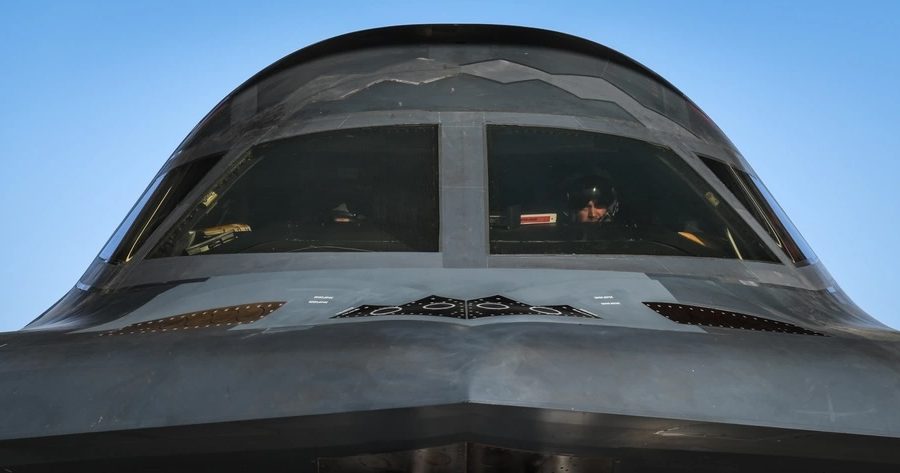A hydraulic system failure is to blame for the December 2022 accident that sparked the fire that torched a B-2 Spirit stealth bomber beyond repair at Whiteman Air Force Base, Mo., the Air Force said in an accident investigation board report published Aug. 5.
The hydraulic failure led the bomber’s left main landing gear to collapse, causing the “Spirit of Hawaii” to skid off the runway and catch fire, the report found. No one was hurt in the accident.
But the service deemed the damage too costly to fix and opted instead to retire the jet. The incident left the Air Force with a fleet of 19 B-2s, down from 21, and closed Whiteman’s sole runway for 10 days as troops collected evidence and cleaned up the mess.
The accident investigation board determined that a sequence valve coupling failed in the left main landing gear, a problem which the board partially attributed to a design flaw. When the gear collapsed, the left wing dragged thousands of feet, sparking flames that led to fuel tank explosions that destroyed much of the aircraft’s left side.
Firefighters were delayed in extinguishing the fire with aqueous film-forming foam because they weren’t sure if it was safe to use the substance on the B-2’s exotic stealth materials, the board added.
Another B-2 experienced a similar mishap in September 2021, when its left landing gear collapsed during an emergency landing at Whiteman. That aircraft, the “Spirit of Georgia,” also skidded onto the grass; the Air Force opted to repair it. No one was injured in the 2021 accident.
Air Force Global Strike Command paused B-2 operations after the 2022 accident to inspect the fleet for similar issues, it said in a press release. While the Air Force said the B-2 fleet could still fly nuclear deterrence and conventional bombing missions during that period “if needed,” the command held off on resuming full flight operations of the Spirit fleet until May 2023—some 17 months later.
The Spirit of Hawaii had launched as a spare with another B-2 heading to Joint Base Pearl Harbor-Hickam, Hawaii. The Spirit of Hawaii had turned around after the lead ship’s crew gave the go-ahead for it to head home, and on final approach to Whiteman with the landing gear extended, caution lights popped on to indicate leaks in the primary and backup hydraulic systems.
The Airmen declared an in-flight emergency. While the left main gear and the nose gear extended properly, the right main gear did not. The crew successfully performed an emergency gear extension, and the plane indicated all three gears were down and locked. But “vulnerabilities” in the landing gear’s design had “caused the lock link assembly to move out of the required [locked] position,” the board said.
Although the left main gear was down and locked, the emergency extension caused a drop in pressure that relaxed it. This led to the hydraulic connector pulling apart, causing a loss of hydraulic pressure and draining the fluid. The left main landing gear collapsed upon touchdown.
“As the [mishap aircraft] continued down the runway, the left wing dragged several thousand feet, rupturing the left fuel surge tank under the wing and causing a fire that spread to the left outboard fuel tank,” the report said.
The B-2 eventually came to a stop with the left wing flaming in the grass. Fuel tank explosions destroyed the left wing, the report said, causing more than $300 million in damage to the aircraft and $27,500 worth of damage to the airfield. The crew did not try to eject and safely exited the bomber on the ground.
Twenty-five CryoFit coupling failures have been reported across the B-2 fleet, according to the report. Of those, 10 have affected the main landing gear hydraulic pressure circuit.
The Spirit of Hawaii had its landing gear updated in June 2022 after noncompliant springs were discovered in the 2021 B-2 accident. The Spirit of Hawaii landed 32 times without incident in the six months between the fix and the mishap.
The bomber incurred more damage while firefighters were slow to stop the flames from spreading, the report said. And a firetruck on base wouldn’t start, further hindering the response.
The fire incident commander “identified the source of the fire as fuel leaking from under the left wing” and directed fire trucks to “attack the fire using water only” instead of foam, believing the foam was only available as a last resort, the report said. However, while the Air Force curbs the foam’s use for non-firefighting purposes, it was approved for extinguishing fires on the B-2 and was not left as a “last resort.”
The Air Force has phased out use of the foam because it contains the cancerous “forever chemicals” known as PFAS.
“Approximately three minutes and 28 seconds after beginning to fight the fire, and because the fire appeared fuel-related, the incident commander authorized” fire trucks to use the foam, the report said, which is “a more effective fire suppressant than water when used to fight flammable liquid fires.” The substance forms a film on the fuel surface, which, along with a blanket of foam, serves to “seal in the flammable vapors, resulting in extinguishment,” the service said. It took 15 minutes to suppress the fire, but not thoroughly extinguish it.
It’s unclear whether the firefighting team should have injected fire suppressants under the bomber’s skin, or what impact that might have had, the service added.
Each B-2 costs upwards of $2 billion apiece. Col. Jesse Lamarand, commander of the 5th Bomb Wing at Minot Air Force Base, N.D., presided over the investigation.


